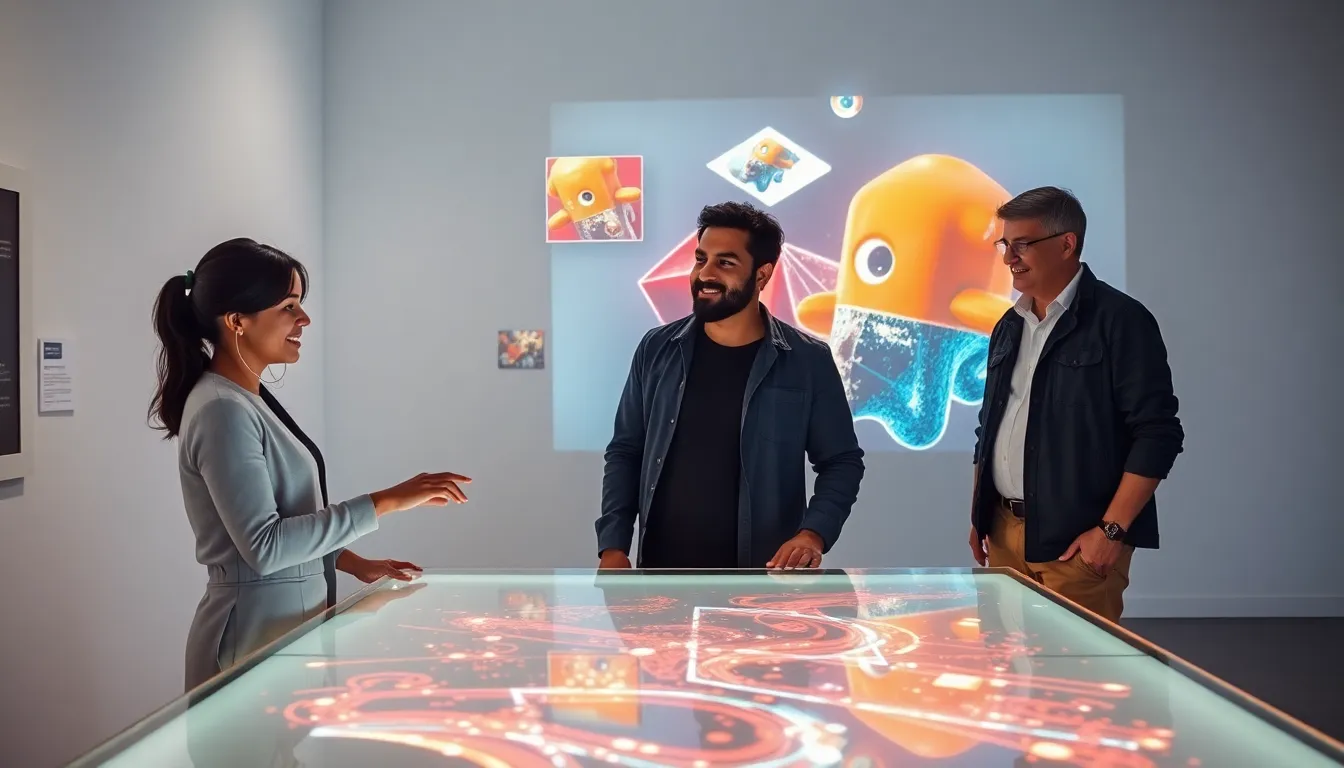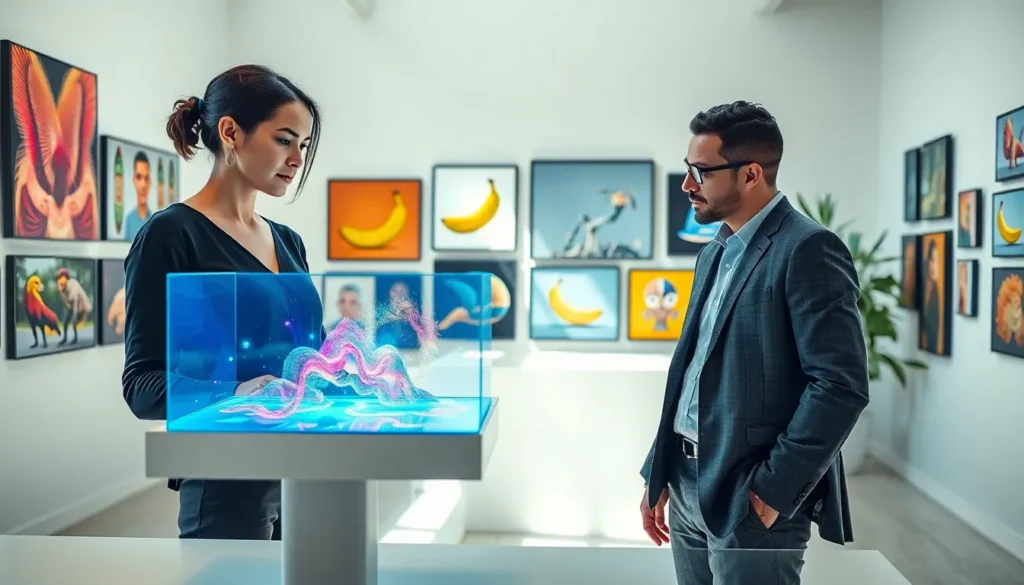In a world where modern life can feel anything but exciting, one thing is clear: technology art brings a splash of color into what might otherwise be a monotonous existence. Imagine a canvas not defined by brushstrokes but by algorithms, pixels, and a touch of whimsy. Sounds like a recipe for fun, right? Buckle up, because we’re diving deep into how creativity gets a tech makeover and ignites a revolution in the art world. From digital tools to bananas, yes you heard that right, we’ll explore the quirks and wonders that make technology art oh-so-intriguing.
Table of Contents
ToggleUnderstanding Technology Art

Technology art represents an innovative blend of creativity and technological advancement. This genre challenges traditional perceptions of artistry, introducing a palette dominated by digital mediums and interactive experiences. Artists often use coding, virtual reality, and augmented reality, transforming how we view the creation process. Imagine visiting a gallery where the paintings react to your movements, or where soundscapes shift with the touch of a button. Here, the fusion of art and technology invites viewers to engage in a multisensory experience, awakening their imagination in ways previously thought impossible.
Gone are the days when artists solely relied on brushes and palettes. With technology, artists can experiment with infinite forms of expression. From generative art created by algorithms to installations that use artificial intelligence, the possibilities are practically limitless. This brave new world of technology art inspires not just artists but also tech enthusiasts, blurring the lines between disciplines.
Also, the accessibility of technology paves the way for a broader range of creators to emerge. With a simple Internet connection and some creativity, anyone can start their journey into this fascinating realm.
The Role of Digital Tools in Artistic Expression
The digital revolution has furnished artists with an arsenal of tools that can enhance their creative capabilities. Software like Adobe Creative Suite, Procreate, and Blender fuels their imaginations, allowing for greater experimentation and precision than ever before. Artists can produce 3D models, intricate animations, and immersive multimedia experiences.
Besides, technology democratizes artistic expression. Online platforms enable budding creators to share their work globally, opening gates that once felt firmly shut. Social media platforms offer artists a space to showcase their projects, engage with other creatives, and even sell their work without the constraints of traditional galleries. This shift not only promotes creativity but also fosters a vibrant community where feedback and collaboration flourish.
Virtual reality (VR) and augmented reality (AR) further expand possibilities for artists. These technologies allow them to create immersive experiences that can transport viewers to different worlds. Wouldn’t it be captivating to step into an artwork? With AR, audiences can interact with art in ways that challenge their perceptions while inviting them to ponder deeper meanings behind each piece.
Exploring the Concept of ‘Banana’ in Art
Bananas in art? It might sound quirky, but this unusual motif has captured the imagination of many artists. The phenomenon often symbolizes more than just a fruit: it delves into themes of consumerism, pop culture, and absurdity. A recent example that created quite a stir was the artwork titled “Comedian,” which featured a banana duct-taped to a wall. It sparked conversations on absurdity and the value of art in contemporary society.
The banana represents how the mundane can be transformed into something profound when captured through an artistic lens. Artists leverage such symbols to challenge societal norms and provoke thought. Whether it’s playful or provocative, the use of ordinary objects offers audiences a chance to engage with complex themes in a light-hearted way. This trend points to the ingenious creativity present in technology art, where anything, including a banana, can become a canvas for discussion.
The Purchase Process: Acquiring Art in the Digital Age
Purchasing art has evolved alongside advancements in technology. The digital age has altered the landscape of art acquisition dramatically. Today, potential buyers can explore virtual galleries and marketplaces at their convenience, transcending geographical limitations. Websites and applications now offer efficient platforms for artists to showcase their work while streamlining the buying process for collectors.
Also, the rise of cryptocurrencies and blockchain technology introduces a new dynamic to art purchases. Artists can now sell their work as non-fungible tokens (NFTs), creating unique digital assets that guarantee authenticity. This shift not only protects creators’ rights but also enhances the buying experience for collectors seeking something truly one-of-a-kind. Buyers can rest easy, knowing they’re purchasing a secure and verifiable piece of art.
But, navigating this digital landscape requires a keen eye and a bit of research. Enthusiasts should familiarize themselves with various platforms and understand the basics of NFT transactions to ensure their investment is worthwhile.
The Influence of RedWebzine on Art and Technology
RedWebzine stands as a pioneering platform at the intersection of art and technology, bridging the gap between these two worlds. This digital magazine curates content that highlights the latest trends, emerging artists, and innovations in technology art. RedWebzine offers a space for discussion, learning, and showcasing brilliant talents that might otherwise go unnoticed.
Also, the platform serves as an insightful resource for artists seeking to navigate the digital landscape. With articles that explore tools, tutorials, and artist features, it empowers creators to investigate deeper into technology art. As readers learn from in-depth pieces, they also gain access to a community that thrives on collaboration and exploration. RedWebzine is more than just a source of information: it inspires creativity and fuels a collective passion for melding technology with artistic expression.
Creating Your Own eBook on Technology Art
Considering the wealth of information surrounding technology art, creating an eBook presents a fantastic opportunity for budding authors. Compiling insights, trends, and personal reflections can not only showcase knowledge but also contribute meaningfully to the dialogue surrounding this genre.
Begin by researching the topics that resonate with you the most, whether it’s the impact of digital tools, significant movements in technology art, or profiles of influential artists. Structure your eBook in a way that flows logically, leading readers through various concepts and discoveries. Incorporating visuals will also enhance engagement, making your eBook not just informative but visually appealing.




